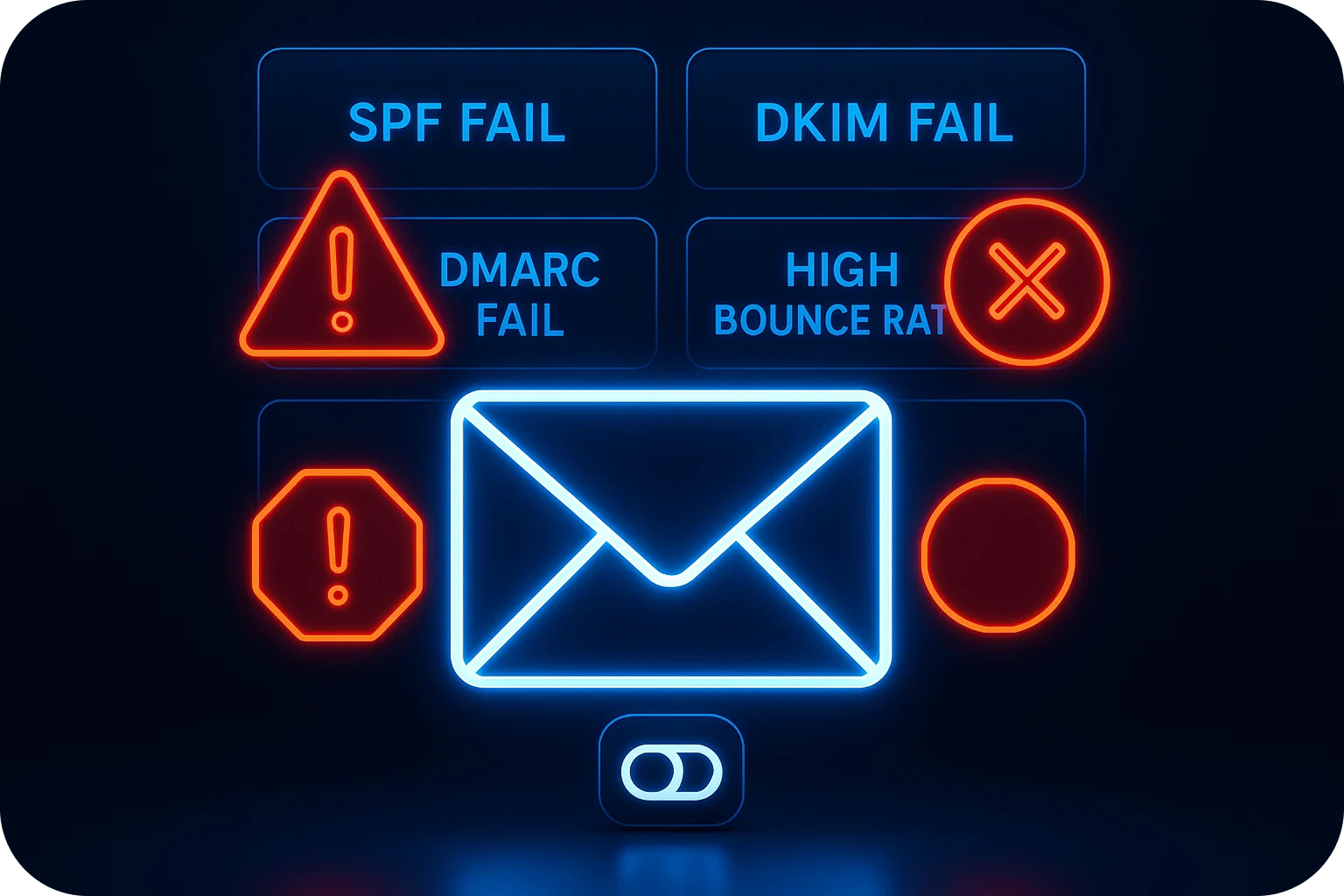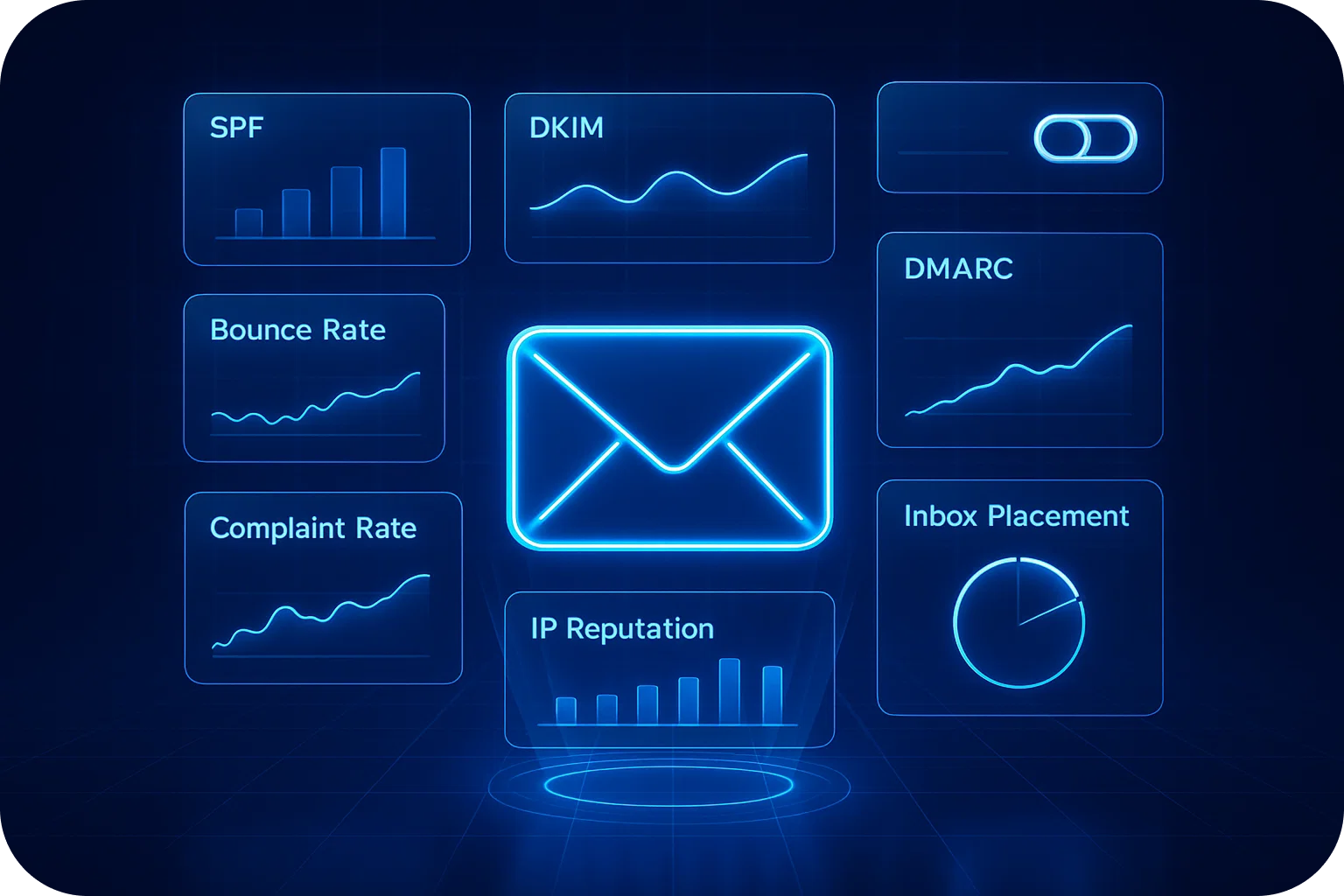Cold Email Metrics Dashboard: The 8 KPIs You Should Monitor Daily
.png)
Running cold email campaigns without tracking the right metrics is like driving blindfolded. You might be moving forward, but you have no idea if you're heading in the right direction or straight into a wall.
For startups and sales teams scaling their outreach, monitoring cold email metrics daily isn't just best practice; it's essential for maintaining sender reputation, maximizing deliverability, and driving real results. The difference between a campaign that generates qualified leads and one that lands in spam folders often comes down to understanding and acting on eight critical KPIs.
Let's break down the metrics that matter most and how to interpret them for optimal campaign performance.
1. Inbox Placement Rate (IPR)
What it measures: The percentage of your emails that land in the primary inbox versus spam or promotions folders.
Why it matters: This is your most critical metric. If your emails aren't reaching the inbox, nothing else matters. A healthy inbox placement rate directly correlates with your sender reputation and email deliverability infrastructure.
Benchmark to aim for: 96-98% inbox placement rate
How to track it: Use seed testing tools that place test addresses across major providers (Gmail, Outlook, Yahoo) before sending campaigns. Monitor where your emails land across different inbox types.
Red flags: If your IPR drops below 90%, pause your campaigns immediately. This indicates serious deliverability issues that will only worsen with continued sending. Common causes include poor domain reputation, inadequate warm-up, or technical DNS configuration problems.
Optimization tips:
- Warm up new domains and inboxes for 3-4 weeks before full-scale sending
- Never exceed 20 emails per inbox per day (maximum 100, but not recommended)
- Limit to 3 inboxes per domain (maximum 5)
- Ensure proper SPF, DKIM, and DMARC records are configured
2. Open Rate
What it measures: The percentage of recipients who opened your email out of total emails delivered.
Why it matters: Open rate indicates how compelling your subject line is and whether your sender name/domain inspires trust. It's your first conversion point in the cold email funnel.
Benchmark to aim for: 40-60% for cold emails (industry average is 30-50%)
How to track it: Most cold email platforms track opens via pixel tracking. Note that privacy features (like Apple's Mail Privacy Protection) can inflate this metric, so interpret alongside other KPIs.
Red flags: Open rates below 30% suggest problems with subject lines, sender reputation, or that you're reaching the wrong audience. Open rates above 80% might indicate tracking issues or that your list is too small to be statistically significant.
Optimization tips:
- A/B test subject lines focusing on personalization and relevance
- Keep subject lines under 50 characters for mobile optimization
- Use the recipient's company name or pain point rather than generic phrases
- Send from a real person's name, not a generic company email
3. Reply Rate
What it measures: The percentage of recipients who responded to your email, regardless of whether the response was positive, negative, or neutral.
Why it matters: Reply rate is the ultimate indicator of email engagement and message relevance. High reply rates also signal to email providers that your messages are wanted, boosting your sender reputation.
Benchmark to aim for: 5-15% reply rate (anything above 10% is excellent)
How to track it: Track all replies, including out-of-office messages, unsubscribes, and "not interested" responses. Segment positive replies separately for conversion tracking.
Red flags: Reply rates below 3% indicate poor targeting, weak messaging, or irrelevant value propositions. If you're getting replies but they're mostly negative, your targeting or approach needs refinement.
Optimization tips:
- End with a clear, low-friction call-to-action (simple yes/no questions work well)
- Personalize beyond first name—reference specific company details or recent news
- Keep emails under 150 words for cold outreach
- Focus on the recipient's problems, not your product features
4. Bounce Rate
What it measures: The percentage of emails that couldn't be delivered, divided into hard bounces (permanent failures) and soft bounces (temporary issues).
Why it matters: High bounce rates devastate your sender reputation. Email providers interpret bounces as a sign you're using poor-quality lists or engaging in spam practices.
Benchmark to aim for: Below 2% total bounce rate (ideally under 1%)
How to track it: Monitor both hard and soft bounces separately. Hard bounces (invalid addresses) are more damaging to reputation than soft bounces (full inboxes, temporary server issues).
Red flags: Bounce rates above 5% will trigger spam filters and damage deliverability across your entire domain. If you're seeing high bounce rates, your list quality is poor or outdated.
Optimization tips:
- Use email verification tools before uploading lists
- Remove hard bounces immediately from your database
- Regularly clean your lists (every 3-6 months minimum)
- Build lists from reliable sources rather than purchasing contact databases
5. Spam Complaint Rate
What it measures: The percentage of recipients who marked your email as spam.
Why it matters: This is the death knell for sender reputation. Even a small number of spam complaints can blacklist your domain and destroy deliverability for months.
Benchmark to aim for: Below 0.1% (one complaint per 1,000 emails)
How to track it: Monitor feedback loops from major email providers and track spam complaints through your sending platform. Note that not all spam complaints are reported back to you.
Red flags: Any spam complaint rate above 0.3% is critical. If you're seeing consistent complaints, your targeting is off, your messaging is too aggressive, or you're not providing clear unsubscribe options.
Optimization tips:
- Always include a clear unsubscribe link in every email
- Honor unsubscribe requests immediately (within 24 hours)
- Avoid spam trigger words like "free," "guarantee," or excessive punctuation
- Target more precisely, broad, untargeted campaigns generate more complaints
6. Click-Through Rate (CTR)
What it measures: The percentage of recipients who clicked on a link in your email.
Why it matters: CTR indicates how compelling your call-to-action is and whether your email content creates enough interest to drive action. For cold emails with calendar links or resource URLs, this is a key conversion metric.
Benchmark to aim for: 2-5% for cold emails (higher for warm audiences)
How to track it: Track clicks on all links separately, calendar booking links, case study URLs, and unsubscribe links tell different stories about engagement.
Red flags: Low CTR with high open rates means your email content isn't compelling enough or your CTA isn't clear. High CTR with low reply rates might indicate curiosity clicks without genuine interest.
Optimization tips:
- Use only one primary CTA per email to avoid decision paralysis
- Make links contextual rather than generic ("see how we helped [similar company]" vs. "click here")
- Consider using calendar booking links for easy scheduling
- Track which types of content (case studies, demos, resources) drive the most clicks
7. Unsubscribe Rate
What it measures: The percentage of recipients who opted out of future communications.
Why it matters: While unsubscribes feel negative, they're actually healthier than spam complaints. A reasonable unsubscribe rate indicates you're reaching people who aren't a fit, and you're respecting their preferences.
Benchmark to aim for: 0.5-2% per campaign
How to track it: Monitor unsubscribe rates per campaign and across sequences. Spikes in unsubscribes after specific emails indicate messaging problems.
Red flags: Unsubscribe rates above 3% suggest poor targeting or overly aggressive messaging. Rates below 0.2% might indicate your unsubscribe link isn't visible enough (which can lead to spam complaints instead).
Optimization tips:
- Make unsubscribe links easy to find, hidden links frustrate recipients into spam complaints
- Consider adding an "update preferences" option alongside unsubscribe
- Review emails with high unsubscribe rates for messaging issues
- Segment your audience better to reduce irrelevant outreach
8. Domain Reputation Score
What it measures: Your sending domain's overall reputation with email providers, typically scored 0-100.
Why it matters: This is the meta-metric that influences everything else. Your domain reputation determines whether email providers trust your messages enough to deliver them to inboxes. It's built over time based on engagement, complaints, bounces, and sending patterns.
Benchmark to aim for: Domain reputation score above 80 (90+ is excellent)
How to track it: Use tools like Google Postmaster Tools, Microsoft SNDS, or third-party reputation monitoring services. Check your domain against blacklists regularly.
Red flags: Scores below 70 indicate serious deliverability problems. Blacklist appearances require immediate action, pause campaigns, and remediate the issues before resuming.
Optimization tips:
- Maintain consistent sending volumes (sudden spikes damage reputation)
- Use dedicated domains for cold outreac,h separate from your primary business domain
- Implement proper email authentication (SPF, DKIM, DMARC)
- Monitor reputation across multiple domains if you're scaling outreach
Building Your Daily Monitoring Routine
Tracking eight metrics daily might seem overwhelming, but with the right dashboard and routine, it becomes second nature. Here's how to structure your daily monitoring:
Morning check (5 minutes):
- Review inbox placement rate and domain reputation
- Check for any blacklist appearances
- Scan bounce and spam complaint rates
Midday review (10 minutes):
- Analyze open and reply rates for campaigns sent in the last 24 hours
- Review actual replies and categorize (positive, neutral, negative)
- Adjust ongoing campaigns based on early performance signals
End-of-day analysis (15 minutes):
- Compare today's metrics against weekly averages
- Identify any anomalies or concerning trends
- Plan optimizations for tomorrow's campaigns
When to Sound the Alarm
Certain metric combinations require immediate action:
Critical scenario 1: Inbox placement rate drops below 90% + bounce rate increases above 3%
Action: Pause all campaigns immediately. Verify DNS records, check for blacklist appearances, and audit your email list quality.
Critical scenario 2: Spam complaint rate above 0.3% + domain reputation score dropping
Action: Stop sending, review your targeting criteria, and improve your unsubscribe visibility. Consider starting fresh with a new domain if reputation is severely damaged.
Critical scenario 3: Open rates above 60% but reply rates below 3%
Action: Your subject lines are working, but your message isn't. Rewrite email body copy focusing on value proposition and clearer CTAs.
The Bottom Line
Cold email success isn't about sending more emails, it's about sending better emails to the right people and continuously optimizing based on data. These eight KPIs give you a complete picture of your campaign health, from technical deliverability to message effectiveness.
Monitor them daily, act on the insights they provide, and you'll build a sustainable cold email operation that generates consistent results without damaging your sender reputation. Remember: in cold email, your reputation is your most valuable asset. Protect it by staying vigilant with your metrics, and you'll scale your outreach successfully while maintaining the deliverability rates that make it all possible.
Start with these benchmarks, track your progress, and adjust your approach based on what the data tells you. Your cold email dashboard isn't just a reporting tool; it's your roadmap to predictable, scalable outreach success.
More articles
Get started now




%201.png)





